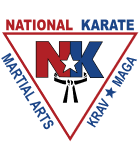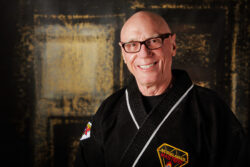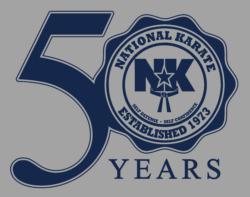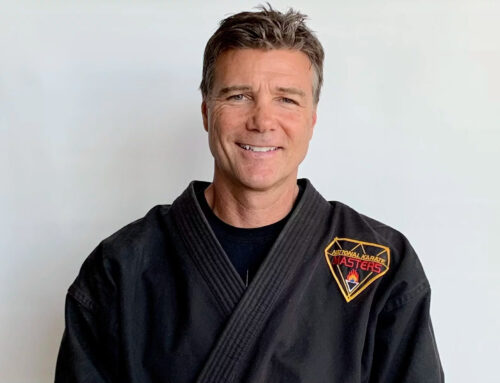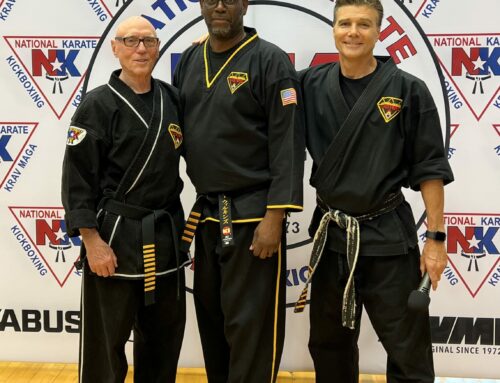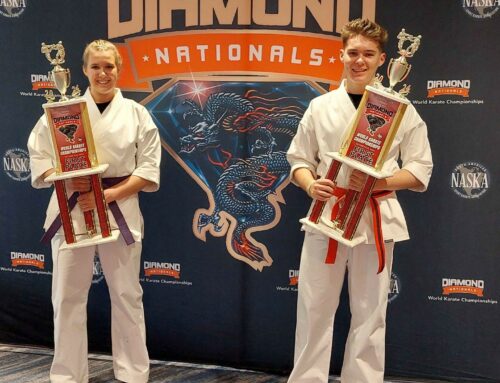To celebrate National Karate’s 50th Anniversary we’ve asked one of the the founders of National Karate, John Worley to share some stories of what the early days of martial arts in America were like. Our founders Grand Master Worley and Grand Master Carnahan are true pioneers of our sport and colleagues of famous martial artists like Bruce Lee, Chuck Norris and Jhoon Rhee. These dedicated martial artists laid the foundation of the martial arts in our country and we are indebted to them for bringing our sport to widespread popularity in the United States. They were there at the beginning and here is a window into what it was like…
What I’ve Seen… By 10th Degree, Grand Master John Worley
I’m often asked, “Why did you start karate?” and “Why did you choose to make martial arts your life’s work?”
In the early 1960’s, martial arts training in America was in its’ infancy and there were very few professional schools. People who trained in martial arts were thought to be “deadly” and black belt holders supposedly were required to “register their hands as deadly weapons”. Of course, nothing of that sort was actually true, but all I know is that training made me feel unique…special. Karate made me feel good about myself. Nothing I had ever done made me feel like that.
In 1968 along with Patty and our daughter Darbi, I had returned to college at North Texas State University in Denton, Texas and was working as a bellman at a Marriott Hotel in Dallas (it was the best job I’d ever had up to that point). My first attempt at college was right after I graduated from high school in 1962 and, to say the least, my college performance had been a major bust. I was far more interested in “college life” than I was in education. As a married man, my second attempt at a higher education was a much different experience. I actually excelled in my studies. I discovered that, if you actually attended the classes and did the homework, college level work wasn’t so hard. I gained a lot of confidence during the twelve months that we were in school. However, my college efforts were interrupted when Patty and I had our second child, John, Jr. and with two young children, we simply couldn’t afford for me to continue my education.
It was while we were in Denton that I had begun to establish myself in karate tournaments. After our trip to California and our promotion to First Degree black belt, I came back to Texas and started trying to figure out what I was going to do with my life. How would I support my family of Patty and our two small children? I was pretty good at employment interviews and took a series of “good” jobs that soon led to frustration for me. I knew what I really wanted to do (karate) but had no idea how that could be accomplished. And then came the opportunity of a lifetime.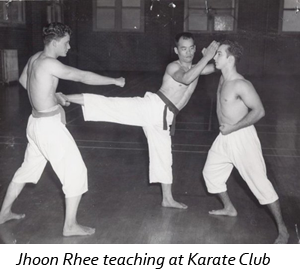
As I was about to leave the latest of my failed employment efforts, I asked Master Rhee if there was a place for me in his organization. He said unfortunately, he didn’t have another teaching job available. I asked if I came, anyway, would he put me at the top of the list when a position became available. He said “you would come here with your family (1500 miles) to a place where you know no one, without a job on the hope that you could eventually teach?” I replied, “I’ll do whatever I have to for work until there is a place for me”. He agreed and one week later my wife and I and our two young children were driving East pulling a small trailer with a very few possessions. It was the start of the greatest adventure of our lives. We drove into the Washington, DC area around two o’clock in the morning. Since we really didn’t know anyone or have any sort of arrangements made for the night, we just drove around looking for a motel.
As we followed signs to “Washington, DC”, it happened that we drove across the Potomac River on the Washington Memorial Bridge which led directly to the Lincoln Memorial. One of the greatest memories of my life was the drive up to the historic tribute to President Lincoln. Patty and our children were dead asleep but I awakened Patty and we drove around and around the Monument…two Texas kids who had hardly ever been out of the state were now moving to one of the world’s great cities. As luck would have it, Mr. Rhee soon decided he would open another school so I never had to wash dishes or dig ditches. In May, 1970, we opened a Jhoon Rhee Institute branch in the Washington, DC suburb in Annandale, Virginia and started the most life-expanding experience of our lives. Teaching karate for the Jhoon Rhee was the most fun I’ve ever had. Along with my brother Pat and fellow Texan Jeff Smith, there were several other young black belt instructors, all of whom were excited about training and martial arts in general. We all worked out together, each pushing the others to reach their potential. Master Rhee, himself, conducted instructor training sessions every week and we learned the basic classical karate that is still being taught in our schools today, some 50 years later.
While I had been promoted to First Degree black belt and had a decent sparring ability, I was soon to learn that Mr. Rhee required that all his staff of instructors teach martial arts to his very lofty standards. I really felt like my “martial arts” training began when we moved to Washington and the Jhoon Rhee Institute (JRI). Mr. Rhee had a very structured curriculum and every stance, block, kick and strike had to be done specifically in his model and to his satisfaction. I was on a very, very steep learning curve and really spent the first several months just learning and perfecting my classical martial arts skills to his satisfaction.
During the Washington, DC years, I had the opportunity to train with some of America’s most outstanding tournament competitors. Pat Worley (already ranked as one of North America’s top ten black belts), Jeff Smith who would also achieve world-wide acclaim and who eventually would win the Light-heavyweight World Championship in the first ever Full-Contact Championships held in Los Angeles in 1975 and other top JRI instructors\fighters were weekly training mates. Our training sessions could get very physical and competitive. While not as talented as the top JRI fighters, I did maximize my potential in those years. I was fortunate to be a team member on some of the JRI teams that fought other teams from the Cleveland, a Texas All-Star team and a team from the Dominican Republic. In 1973 and at the peak of my physical skill, I suffered a traumatic knee injury. I had torn ligaments and cartilage and, unfortunately, medical science was not nearly as advanced as today. My surgery left me with a knee that was never to regain the strength or explosiveness needed to compete at the highest levels.
While I tried to make a come-back, I really was never able to reach competitive success. I turned my competition interest in to doing everything I could to develop my students to help them become champions in their own right.
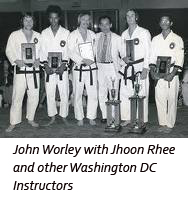
Since the introduction of sport martial arts tournaments in the early 1960s, sparring competitions had been very rough and tumble bare knuckle affairs since there wasn’t any sort of protective equipment used. Because of the potential for painful experiences, sparring was not very appealing to most men and women and especially to children. It was simply too easy to get injured and although the fighters exercised a certain amount of “control” in their kicks and punches, physical contact was a part of every competition. Split lips, bloody noses and bruised ribs were the normal price that competitors paid to try and take home a trophy.
My brother Pat had been dominating martial arts competitions on the East Coast and had won Mr. Rhee’s Washington Nationals in 1971. The “Nationals” was one of the three biggest events in America at that time. Based on that great victory, Pat had been listed as one of the top ten fighters in North America by “Black Belt Magazine”, the world’s leading martial arts publication. However, shortly after that big victory, Pat suffered a serious injury when he was accidentally kicked in the face in another tournament. Pat had a broken cheekbone and a broken nose and was out of competition for months following his injury. Based on that incident, Mr Rhee decided that there had to be a way to offer better safety in high level competition.
He began investigating the use of foam rubber padding to create protective hand and foot pads. In those early days, we (his staff of instructors) became the “crash test dummies” for his inventions. He would come to our workouts, strap some crude foam rubber pads on our hands and feet and say “go hit each other”. After a few minutes of some pretty intense sparring, we staggered back into his office and would suggest, “Mr. Rhee…please, thicker foam”! After probably 10 different versions of what he called “Saf-T-Punch and Saf-T-Kick, my brother Pat and Jeff Smith wore the pads in an actual tournament in St Louis for the first time in 1972. There were very mixed responses to the pads; some very traditional fighters laughed and called them “duck feet”, some thought they would be able to actually hit harder now but others saw the potential for a much improved level of safety. But, regardless of the initial response from the competitors, the sparring gear caught on quickly and sparring sessions, both in the schools and in tournaments, had been changed forever.
Not long after the introduction of the sparring gear, Mr. Rhee turned his attention in a completely different direction. He believed there was as much potential for growth in the classical aspects of martial arts as in the fighting side. At one of our staff workouts, he arrived with a small audio recorder under his arm and said “I’ve been developing what I call ‘martial ballet’.” For the first time, music had been added to a classical martial art “form or kata”. He demonstrated a pattern that he had developed and had choreographed to the classical music theme from the movie “Exodus”. We all watched, transfixed, as he demonstrated the form. Mr. Rhee had great physical ability and his form, enhanced by the music left us all speechless and in awe. It was unlike anything any of us had ever seen and introduced an element for martial arts tournament competitions that brought about growth unlike any previous development. To this day, music is an integral part of martial arts competitions all over the world.
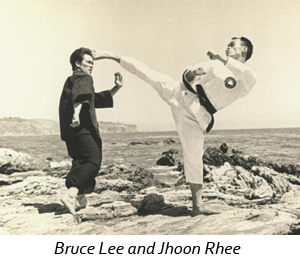
By: John Worley
10th Degree Grand Master
Cofounder National Karate Institute of Martial Arts
To Read Part 3 of Master Worley’s Story – The Founding of National Karate – Click Here
Would you like to meet Grand Master Worley? On June 10th, 2023 we will have him in Chicago to teach a mass karate class to our National Karate students aged 8 years and older. Ask your instructor for details!
